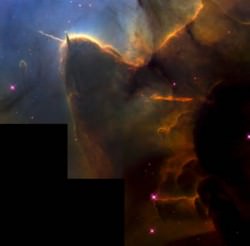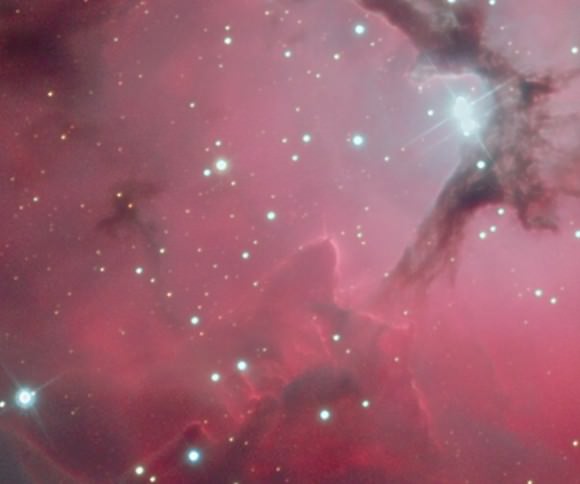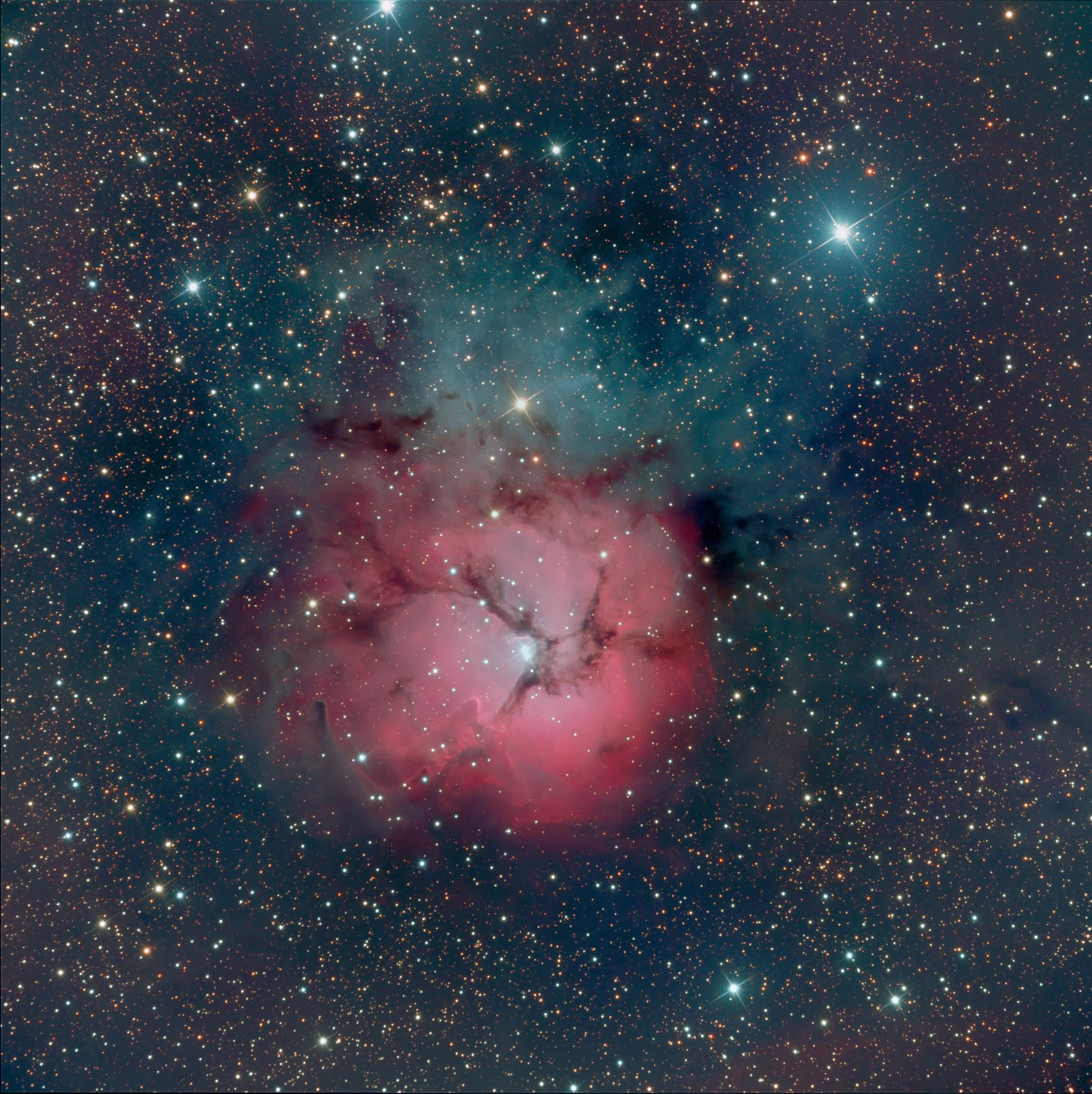[/caption]
Almost everyone who is familiar with space images has seen this beautiful and color emission and reflection nebula – but take a really close look. This isn’t a Hubble image. It was done with a ground based camera!
When looking at M20 through a telescope, what you will see won’t match the photo above, while what is normally presented in science journals is colorful. Why? Well, when it comes to photographs, exposure times and wavelengths causes the different colors you see. Photographically, the red emission nebula contained within Messier 20 has a bright blue star cluster in it central portion. It glows red because the ultraviolet light of the stars ionizes the hydrogen gas, which then recombines and emits the characteristic red hydrogen-alpha light captured on film. Further away, the radiation from these hot, young stars becomes too weak to ionize the hydrogen. Now the gas and dust glows blue by reflection!
Of course, there are other ways of looking at Messier objects, too. It was my great fortune on Saturday night to have an opportunity to study M20 through an image intensifier – a highly complex piece of equipment which uses x-rays and produces a ‘live’ image feed which is displayed on a binocular like eyepiece screen. I cannot even begin to describe to you what this does to observing, except to say that it opens a dimension to to eyes never before experienced. No matter how it is observed, the Trifid – or “three lobed” nebula has a distinctive set of dark dust lanes which divide it. These also have a classification of their own and were cataloged by E.E. Barnard as dark nebula Barnard 85 (B 85).
 In 1999 the Hubble Space Telescope took this photograph – a look deep into the Trifid nebula at some of its star forming regions and found a stellar jet poking its way into the cloud, like a fabulous twisted antenna. Inside the exhaust column is a new star waiting to be born, yet sometime over the next 10,000 years the central massive star will probably erode away all of its material before it can fully form. Nearby a stalk stands waiting… Like the jet, it is also a stellar nursery – one with an EGG (evaporating gaseous globule) at its tip – a condensed cloud of gas able to survive so far. “If our interpretation is correct, the microjet may be the last gasp from a star that was cut off from its supply lines 100,000 years ago.” says Jeff Hester of the Department of Physics & Astronomy, “The vast majority of stars like our sun form not in isolation, but in the neighborhood of massive, powerful stars. HST observations of the Trifid Nebula provide a window on the nature of star formation in the vicinity of massive stars, as well as a spectacular snapshot of the “ecology” from which stars like our sun emerge.”
In 1999 the Hubble Space Telescope took this photograph – a look deep into the Trifid nebula at some of its star forming regions and found a stellar jet poking its way into the cloud, like a fabulous twisted antenna. Inside the exhaust column is a new star waiting to be born, yet sometime over the next 10,000 years the central massive star will probably erode away all of its material before it can fully form. Nearby a stalk stands waiting… Like the jet, it is also a stellar nursery – one with an EGG (evaporating gaseous globule) at its tip – a condensed cloud of gas able to survive so far. “If our interpretation is correct, the microjet may be the last gasp from a star that was cut off from its supply lines 100,000 years ago.” says Jeff Hester of the Department of Physics & Astronomy, “The vast majority of stars like our sun form not in isolation, but in the neighborhood of massive, powerful stars. HST observations of the Trifid Nebula provide a window on the nature of star formation in the vicinity of massive stars, as well as a spectacular snapshot of the “ecology” from which stars like our sun emerge.”
But, is it possible for those of us here on the ground to perform our own deep studies of regions of space like the Trifid Nebula? The answer is yes. Take a look at this small frame clipped from the full sized image you see above. While the colors haven’t been processed the same, those EGGs are there!

It’s a cinch that those of us that don’t have a multitude of titles behind our names are ever going to be allowed Hubble time… even at this late stage of the game. You know our findings will never be placed in the hallowed journals of science. But, why should the scientists be allowed to have all the fun? While images like Eddie’s might be considered “amateur”, it is anything but. While he’s chosen to reveal it in an artistic format, you must stop to think about how much information has been collected inside of his raw data. Unlike a simple film photograph, CCD imaging gathers huge amounts of information that’s processed out by what data is desired. “Velocity maps of the inner regions of the bright H II regions NGC 6514 were made with unprecedented spatial and spectral resolution in the 5007 A line of forbidden O III. In addition to the advantages of an instrumental full width at half-maximum intensity of only 5.4 km/s, the small thermal width of the heavy oxygen ion also allows determination of accurate line widths and velocities.” says C.R. O’Dell (et al), “The CCD spectra were numerically fitted to Gaussian line profiles and revealed two separate velocity systems in NGC 6523. The data sets of radial velocities were used to derive the dependence of the most probable turbulent velocities upon the sample sizes, and the spatial dependence of the structure function. These relationships are the basic functions for comparison with the predictions of the models for turbulence in H II regions.”
To me, one of the most fascinating aspects of Mr. Trimarchi’s picture wasn’t so much the huge revelation of all the Herbig-Haro objects – but a tiny, fine detail that you probably took for granted when you looked at it. Dust extinction… There’s a lot of very exiting things in that photograph, but there’s a detail he left in there that most other photographers filter out! The studies of C.R. O’Dell taught me to take a much closer look a certain properties in astrophotos, because I might see something that others missed, and in this case its a huge amount of dust extinction which he proved to exist around M20 many, many years ago. (Like back when my telescopes still had training wheels.)
Why are things like that important? In this circumstance, knowing there was more dust there than should have been lead to further investigations – and those in turn led to a discovery: “We report the discovery of a new candidate barrel-shaped supernova remnant (SNR) lying adjacent to M20 and two shell-type features to the north and east of SNR W28.” says F. Yusef-Zadeh (et al), ” Future observations should clarify whether the nonthermal shell fragment is either part of W20 or yet another previously unidentified shell-type SNR.”
Keep those cameras rolling… Who knows what we may find tomorrow?
Many thanks to Eddie Trimarchi of Southern Galactic for sharing this wonderul image with us!


Hi Tammy!
What was the aperature of the telescope used for this observation with this image intensifier?
hey, aqua…
eddie’s image wasn’t done with an intensifier. it was with a 16″ RCOS with Apogee Alta U9000 camera and a 90 minute exposure.
i did, however, optically study m20 with an image intensifier… and the experience is incredible. because you’re using x-rays, you don’t view as you would through an eyepiece – although the equipment is hooked to a telescope’s focuser. the apparatus looks similar to a pair of binoculars, but the view is greenish – because you’re looking at a screen composite.
there’s only one word to desribe it. WOW.
no filter, no aperture, no photo… nothing i have ever witnessed compares to what it can do. obscuring dust becomes so clean and so clarified, it’s like you could reach out and touch it. details like globules snap right out… it’s totally amazing.
look for a review of this instrument in the very near future! they might not be for everybody, but even moonlight doesn’t stop them. put one on a 16″ obsession telescope? and lawdy, lawdy miss claudie…
who needs coffee? i was high all night!
Tammy, thanks again for so thoroughly researching one of the skies best known nebula-cluster complexes! Questions about true-color representations have always fascinated me, and your article and an earlier reply reminded me of David Malin’s book ” A View of the Universe”. On page 110 of his book, Figure 5.26 shows a distinctly greenish tinge of this portion of the nebula and the attribute for the greenish tint is “Where the reflection nebulosity is seen through dust at the edge of the Trifid Nebula most of the blue light is adsorbed, leaving a fainter, green-yellow hue” Most interesting!
“i did, however, optically study m20 with an image intensifier”
“there’s only one word to desribe it. WOW.”
I would sell both my kidneys to get my hands on a nice image intensifier. The problem is, living in Australia, that all the good ones are made in the US, and the technology for 3rd generation intensifiers is classified as ‘restricted to American use only’. Hence, they cannot be shipped out of, or taken out of, the US. I would consider smuggling one out because they are that cool, but something tells me that US security would probably end up sticking me in Guantanamo first and ask questions later…
I will never be able to dissociate the Trifid from the episode of classic Trek with the two lookalike guys causing trouble on the Enterprise, who somehow came from a spatial phenomenon that was represented by this nebula.
Tammy, you mention in your article C.R. O’Dell’s comment on the large amount of dust surrounding M 20 . Indeed, I mentioned in a comment above about ‘greenish’-colored nebulae in the outskirts of M 20 (which you can see in Eddie’s image at the 12 to 2 o’clock position). And O’Dell and others are quite correct. The cluster and emission nebula portion of M 20 is completely surrounded by dust (i.e. a reflection nebula). This dust shroud is usually visible in deep, long (cumulative) exposure images. I found this example of a deep 9 hour exposure of M 20 by Robert Gendler (although the true colors are slightly off) here: http://www.robgendlerastropics.com/M20NM.html . I’ve seen even deeper amateur images of M 20. Anyone out there with a link to very deep image of M 20 (color, mapped color or black & white) showing the full extent of the dust and reflection nebula ?
@ Tammy, do you recall what ‘generation’ image intensifier you used? Gen 2 or Gen 3, for example. @ Astrofiend, I feel for you. The average American has little knowledge of what the US government considers export contraband . I know just having certain encryption software on computers is considered contraband, also, and thus must be deleted from your computer or you can’t take the computer out of the US (this is a weird restriction as the encryption software (RSA ?) is available for free to anyone on the internet. I understand why these restrictions are in place. I also empathize with Astrofiend’s situation 🙁
When I’m over there later this year, I’m going to buy one and ship it back somehow. I know that I won’t be ripping it apart to discern the lofty secrets of the technology – I just want Hubble in my backyard. So therefore in my mind my deceit and illegal activity is fully justified. In fact, I would be a poor excuse for a human being if I didn’t go ahead with my dastardly plan.
To bad Australia is so piss-weak when it comes to goods manufacture that we can’t be bothered making these things ourselves and instead ship it all out to countries where they can get away with paying people 1 cent per week with no rest breaks…